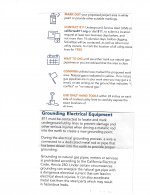In that one case of the open neutral, I measured more than 1 amp on a ground rod. I shut everything down and didn't do further testing at the risk of frying things and having a fire start, of course. But I did snag that measurement on rod and was pretty amazed that so much current could run through the soil. Good, moist, compacted soil can provide good connections to the rod though. There are so many parallel connections in the earth that a lot of current can run. Tapping into it is the hard part, but the parallel paths are there once you do tap in. Of course we should NOT be using the earth as a conductor, either, and should be using intended cables only. While some current on the earth is inevitable in our multi-grounded system, it can be limited through good and proper practices.
Most important: run much larger neutrals or add another line (5-wire system) as a parallel neutral. Ensure all neutral connections are permanent and resistant to damage/corrosion/break from moisture and vibration and other movement over time. Use electronic devices to isolate, identify/clear faults, and add impedance where possible to improper earth/pipes/etc paths, thereby forcing current back on the correct path. Don't create parallel conductors that take a different physical path - this splits current and causes magnetic fields, the transformer effect, health risk, induced current, etc.
We can get there and keep improving. This is a great discussion. I'm very thankful for it.
Here is a petition to change NEC/plumbing codes to end the issue of using the water pipe/sewer pipe as a low-impedance parallel conductor.
Change National Electric Code and Plumbing Code to End Using Water Pipes as Electrical Conductors
www.ipetitions.com
If anyone here likes the wording of the petition enough to be willing to publicly sign it, let me know. I'd be happy to list your name and company as well. Thanks for your support!




